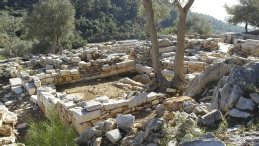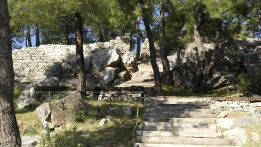PEDASA
Pedesa,which was the capital of all the Leleg cities in Caria are region, is 1,5 miles distance from Bitez Village and covers such an extensive land running between the Torba and Bitez harbors. Homer mentions Lelegs and the city of Pedasos in Troad region. He tells us people of PEDASA lived by the Satnioeus River and they sided with Trojans during the Trojan War. After the Trojan war, Lelegs moved to south and settled in Caria region where they founded 8 Leleg cities. The most important of all these cities was Pedesos and it was located above the city of Halicarnass. This very important information whıch was given by historian Herodotus and helped so much for the discovery of the PEDASA. Lelegs even kept the name of their mother city “Pedesa”
Many travelers and historians such as Paton, Myres, Mauiri and Cook visited the town and published some articles about it. Thanks to Athenian tax records, exact and correct location of the city was set by the studies of scholar such as Cook and Bean. Eventually, after their long survey running from 1999 to 2006, Adnan Diler from Muğla University started the excavations at PEDASA. The inscriptions, giving the name of PEDASA and name of the main goddess of the city, Athena, confirmed strongly that the site was certainly PEDASA. Among the 8 Leleg cities in the region, PEDASA is the easiest site to visit. It is suggested that the name of the ancient city came from Luwian Language and meant “watery place” or “goats path”. Archeological digs carried out in PEDASA revealed that the city was inhabited from 2000 BC to 1300 AD. The city bears the features of a typical Leleg city with its Acropolis, defense walls, monumental tombs, agricultural terraces and farm houses. The golden age of Pedesa 6th and 5th centuries BC. This peaceful times was twice interrupted by Persian attacks. People of PEDASA fought heroically against the Persian armies twice. First main Persian attack was 546 BC, and Persians attacked to Caria under the commandment of Persian General Harpagus. Although Harpagus had a strong resistance of people of Pedesa, he eventually captured Caria and Lycia.
Second major Persian attack was in 497 BC. After the famous Ionian Riot against Persians, another famous Persian General Dariuses came to Anatolia to punish the cities involved in the Riot. After Ionia, he advanced toward Caria and defeated the Carians (assembling at the white columns) near the Marsias River. Having Retreated to Labraunda, Carians decided to fight once more against Persians, but they had even heavier casualties and they had to retreat Caria. But in the following days, the people of PEDASA destroyed nearly whole Persian army during a night ambush on the way to PEDASA. During this night attack, Pedesians killed also most of Persian commanders including Daurises. But It didn't take long for Persians armies to capture Caria and Lycia again. After the defeat of people of Pedesa, Persians forced the inhabitants of the city to leave their town and settle at the vicinity of Miletos. New city was named after mither city and called “Pidesa”. So in summary, we can say that Pedesa was only Leleg city stopping the Persian armies twice. Carian Historian Herodotus gives idea about the location of Pedesa and the temple of Athena:
“When something bad happened to People of Pedesa or to their neighbors, the priestess of Athena Temple had a beard growing. This strange event happened 3 times”

Adnan Diler indicate that these two sad events were Persian Attacks and the third one was possibly a strong earthquake.
When Attica–Delos League was formed against Persians, At the beginning Pedesa paid two talents to the league but later on the tax was diminished to 1 talent.
Second disaster Pedesa came during the time of Mausolos. When he decided to move the capital of Caria from Mylasa to Halicarnassus, he also forced the population of 6 Leleg cities into his new capital city, Halicarnassus. Not only he wanted to increase the population of his capital, but he also wanted to erase the Leleg cities from the stage of history just trying to prevent them from rioting against him in the future.
İn the end of the 3. century, Pedesa was Used by Macedonian King Philip as headquarters for his Army.
Archeological digs indicated that Pedesa was not completely abandoned after these two forced migrations and Life continued during the Hellenistic and Roman area. This fact is confirmed by pottery and roof tiles discovered during digs.
During excavation, archeologist discovered the remains of the Athena Temple, mentioned by Herodotus. This square plan temple, with the columns lining at the front side, is dated to late archaic and early classical periods because of terra cotta statues pieces of Goddess Athena discovered at temple site. Also an inscription ending with the name of goddess Athena is a further proof for the existence of the Athena Temple. According to Herodotus, this was an oracle temple.
PEDASA Today:
Visitors to Pedesa, they first come across with the remains of the famous Athena Temple. Mentioned by Herodotus, the Athena temple was the major shrine in Pedesa. Wide and paved sacred road running between the temple and acropolis can be seen clearly in the south of the temple.
Below the sacred road, one can see a well-preserved tower with impressive masonry. When Mausolos forced people of Lelegian cities to leave their homes, he had many watch towers built just to prevent people from returning to their homes.
Acropolis
Pedesa Acropolis, which is located on a high hill and surrounded by impressive walls, covers an area with houses and shops. A big building in the center identified as a “megaron” was possibly a palace for the king and it dates to 7th century BC. Acropolis witnessed the continuity of the settlement up to the late Byzantine era when there was a revival in Pedesa before it was abandoned.

